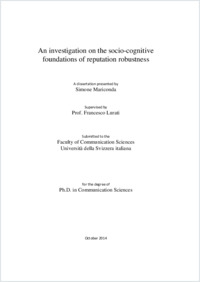An investigation on the socio-cognitive foundations of reputation robustness
- Mariconda, Simone
- Lurati, Francesco (Degree supervisor)
-
10.10.2014
202
Thèse de doctorat: Università della Svizzera italiana, 2014 (jury note: Summa cum laude)
English
Scholars have consistently found that a positive reputation can lead to many benefits for organizations (e.g., Cable & Turban, 2003; Deephouse, 2000; Rindova et al., 2005; Roberts & Dowling, 2002), thereby constituting a fundamental resource for competitive advantage (Barney, 1991). As a result, academics have advocated for a better understanding of what makes reputations stable to the effects of negative events and/or information (e.g., Carter & Ruefli, 2006; Flanagan & O’Shaughnessy, 2005; Love & Kraatz, 2009). However, despite such an acknowledgement, we still know relatively little about what makes a firm’s reputation resistant to new events or information, apart from the fact that highly positive reputations are likely to be more resistant (Coombs & Holladay, 2006; Flanagan & O’Shaughnessy, 2005; Love & Kraatz, 2009). To date, scholars who have examined similar topics have looked at reputation stickiness (e.g., Schultz et al., 2001), meaning stability over time in absence of disruptions, and reputation resilience (Rhee & Valdez, 2009), referring to the ability of the reputation to recover after disruptions. This dissertation can be positioned in relation to these two other terms as I look at the stability of a firm’s reputation in the presence of events and/or information that can potentially change it. In this regard I use the term reputation robustness. After an initial chapter reviewing the literature on organizational reputation, this dissertation comprises three other chapters investigating different facets of the same phenomenon. In chapter two, I introduce the concept of reputation robustness in order to help explain why the reputation of some organizations is more robust against negative events than the reputation of other organizations. By building on a review of extant reputation research, I identify two sets of factors that are relevant for the understanding of reputation: cognitive and contextual factors. Starting from this review, I put forward a series of propositions on the role of the identified factors in moderating the effect of negative events on stakeholders’ reputation judgments and explain how this improves our understanding of reputation management. In chapter three, I elaborate on the role of familiarity in making people’s reputation judgment more robust in light of new information and investigate such a relationship empirically through two experiments. Results lend support for the hypothesis that familiarity mitigates the effect of both positive and negative information on people’s reputation judgments. The fourth chapter focuses on the role of ambivalence in moderating the effect of new information, but also more generally in influencing the way in which new information regarding an organization is interpreted. Through one experiment, I find that the reputation judgments of highly ambivalent people are more influenced by new information. At the same time, I find that highly ambivalent people use new information to reduce their sense of ambivalence toward the focal organization, when possible. Overall, this dissertation contributes to research on organizational reputation by improving the understanding of the variables influencing reputation’s robustness to new events or information. In particular, the findings demonstrate that there is more to reputation than its level (whether bad or good) that might cause it to be more or less robust, as suggested by extant research. As discussed in the thesis, these variables are related to stakeholders’ cognitive and contextual characteristics and go beyond the ability of the organization to consistently deliver a positive performance.
- Language
-
- English
- Classification
- Information, communication and media sciences
- License
-
License undefined
- Identifiers
-
- RERO DOC 232698
- URN urn:nbn:ch:rero-006-113411
- ARK ark:/12658/srd1318609
- Persistent URL
- https://n2t.net/ark:/12658/srd1318609
Statistics
Document views: 288
File downloads:
- Texte intégral: 183
